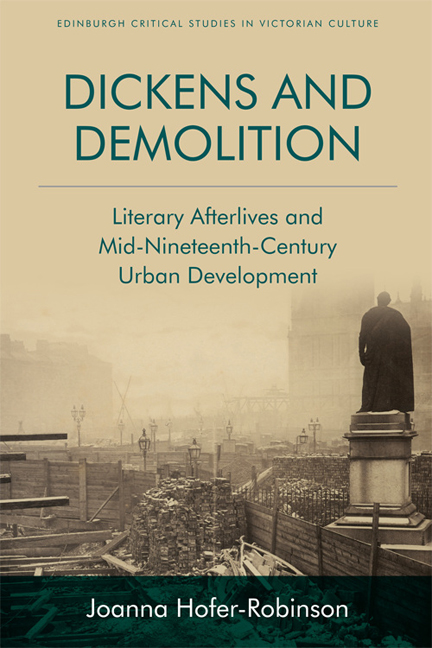Book contents
- Frontmatter
- Contents
- List of Illustration
- Acknowledgements
- Series Editor’s Preface
- Abbreviations and a Note on Editions
- Dedication
- Introduction
- 1 Charles Dickens and Metropolitan Improvements
- 2 Sets and the City: Staging London and Oliver Twist
- 3 Dickensian Afterlives and the Demolition of Field Lane
- 4 Paperwork and Philanthropy: Dickens’s Involvement in Metropolitan Improvement
- 5 From Sanit ary Reform to Cultural Memory: The Case of Jacob’s Island
- Coda
- Archival Sources and a Note on Method
- Select Bibliography
- Index
- Plate Section
Introduction
Published online by Cambridge University Press: 29 April 2021
- Frontmatter
- Contents
- List of Illustration
- Acknowledgements
- Series Editor’s Preface
- Abbreviations and a Note on Editions
- Dedication
- Introduction
- 1 Charles Dickens and Metropolitan Improvements
- 2 Sets and the City: Staging London and Oliver Twist
- 3 Dickensian Afterlives and the Demolition of Field Lane
- 4 Paperwork and Philanthropy: Dickens’s Involvement in Metropolitan Improvement
- 5 From Sanit ary Reform to Cultural Memory: The Case of Jacob’s Island
- Coda
- Archival Sources and a Note on Method
- Select Bibliography
- Index
- Plate Section
Summary
What has become of the Saracen's Head on Snow Hill, where Mr. Squeers received his unhappy pupils, in ‘Nicholas Nickleby’? Who can find the true ‘Old Curiosity Shop’ near Tower Hill, or Quilp's wharf, or the den of Fagin in Field Lane, or the scene of Bill Sikes’ death at Jacob's Island in Bermondsey?
Large-scale demolition and construction projects changed London's built environment profoundly over the course of the nineteenth century. Street layouts were altered, landmarks were removed, houses and businesses were torn down, and thousands of people were displaced. By 1894, when the Illustrated London News asked readers what had happened to Charles Dickens's London, the Saracen's Head and Field Lane had been cleared to make way for new infrastructure, and Jacob's Island had been redeveloped to improve its previously insanitary conditions. Dickens reinforced received ideas about the cultural and social identities of these places when he chose them as the setting for plots dealing with nefarious characters or underhand activities. For many middle-class readers, these place names would have evoked dangerous associations from Newgate novels or newspaper reports about crime or prostitution. Yet despite the wider notoriety of many slum areas, later commentators often used Dickens's characters and stories as representational devices to crystalise and convey their negative connotations, and to talk about the physical redevelopment of the cityscape.
The imaginative and the material intertwine in the Illustrated London News's representation of London's modernisation in the above quotation. On the one hand, the journalist's fictional referents articulate how embedded social, cultural or historical associations are challenged by physical changes to the built environment, which destroy or alter prior landmarks or pathways. The pattern of rhetorical questions reinforces her or his disorientation in the modern city when familiar sites are removed. But, on the other hand, Dickens is evoked as a common property through which readers can envision themselves as part of a richly historical and integrated urban matrix. It allows readers to conceive London's past and present in reference to shared images of an imagined history, and – in so doing – to see themselves as part of an established community. Indeed, the utility of Dickens for constructing broader spatial or communal identities is evident in the material legacies of his fiction in London's built environment.
- Type
- Chapter
- Information
- Dickens and DemolitionLiterary Afterlives and Mid-Nineteenth Century Urban Development, pp. 1 - 18Publisher: Edinburgh University PressPrint publication year: 2018



